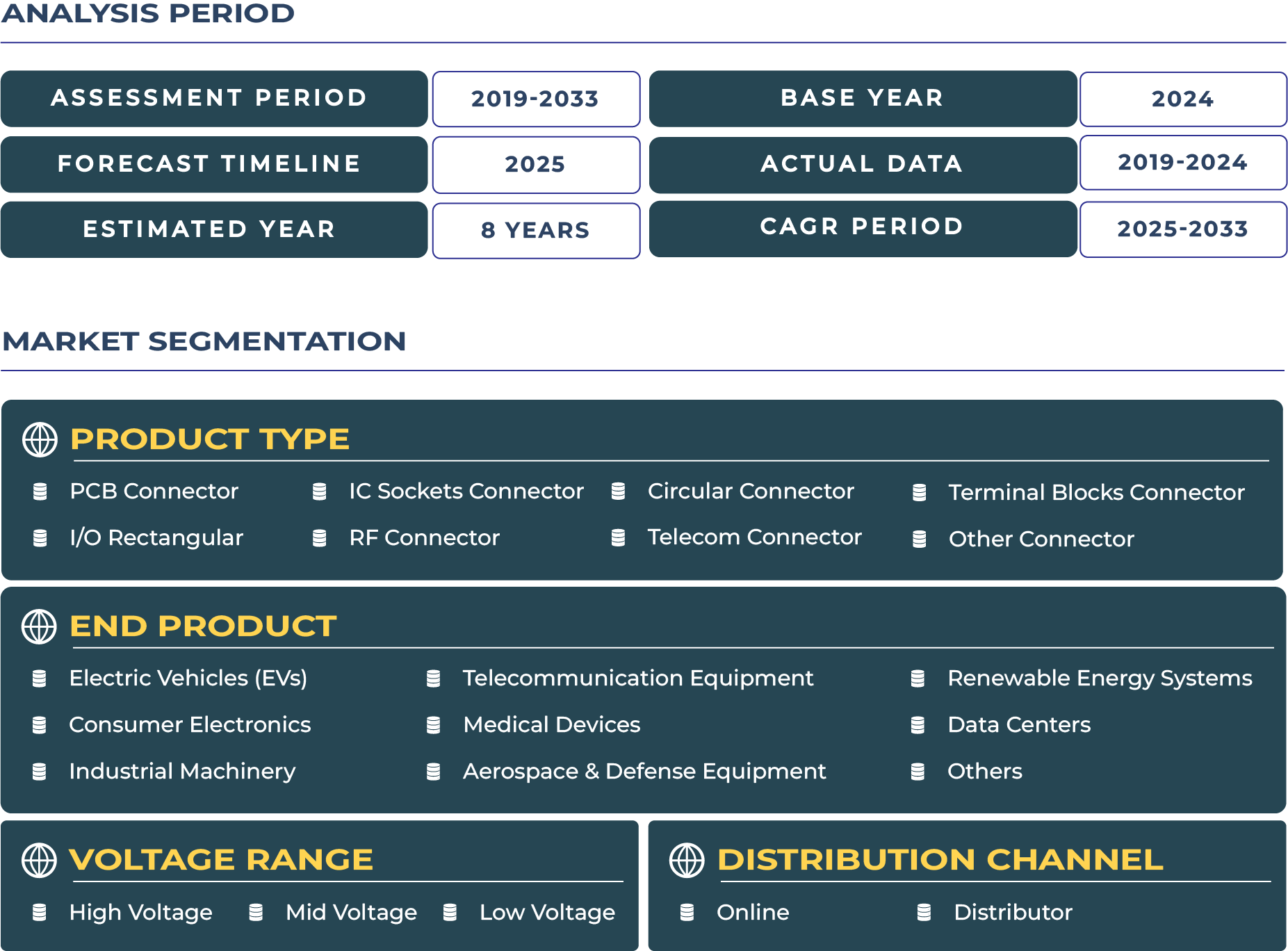Kuwait Connector Market Outlook
The connector market in Kuwait is undergoing a pivotal transformation, emerging as a critical enabler of cross-industry connectivity across electric vehicles (EVs), renewable energy, digital infrastructure, and telecommunications. According to David Gomes, Manager – Semiconductor, Kuwait connector market is on track to grow at a steady CAGR through 2033, underpinned by rising EV adoption, data center expansion, smart manufacturing, and energy diversification efforts. This momentum reflects not only technology-led demand but also the country’s shifting industrial priorities and climate-responsive infrastructure strategy.
One of the most significant contributors to the growth of connectors in Kuwait is the accelerating development of EV infrastructure. Despite EVs comprising less than 1% of Kuwait's passenger vehicles, the government has rolled out targeted incentives including import tax waivers and multi-year battery warranties to boost adoption. The resulting demand for high-performance connectors—particularly for fast-charging stations designed to operate efficiently under Kuwait’s extreme heat—is spurring local innovation. Companies collaborating with the Ministry of Electricity and Water are deploying thermal management systems integrated with charging connectors, addressing both heat resilience and operational uptime. Landmark developments like "EV City" at Kuwait Ports Authority are positioning the nation as a logistics and EV manufacturing hub, further intensifying the need for robust EV-grade connector systems.
The digital transformation agenda is another key growth pillar. Kuwait’s increasing cloud adoption and data sovereignty initiatives are driving the proliferation of local data centers, which rely heavily on secure and scalable connector ecosystems. Google Cloud’s commitment to building three data centers, coupled with cloud training for over 3,000 professionals, marks a paradigm shift in Kuwait’s digital readiness. As David Gomes notes, these developments are placing data-grade connectors at the core of cloud infrastructure, supporting high-speed, low-latency communication across servers, switches, and storage nodes. Additionally, Kuwait’s strategic “Iraq Route” terrestrial cable project offers a secure alternative to undersea networks, demanding connectors capable of maintaining 100 Gbps transmission capacity—ideal for hyperscale data workloads and sovereign connectivity.
Energy transition strategies are also amplifying the demand for advanced connector solutions. With over 30% of Kuwait’s energy expected to come from renewables by 2030, connector technologies are essential in bridging photovoltaic arrays, wind farms, and energy storage systems to the national grid. Projects like the $570 million Gulf Electricity Interconnection Expansion and the Shagaya Renewable Energy Complex are not only increasing renewable output but also setting new benchmarks in connector durability, voltage management, and thermal conductivity. Emerging sectors such as green hydrogen and second-generation biofuels also require highly specialized connectors that meet evolving international safety and energy efficiency standards—presenting new revenue avenues for both domestic and international connector manufacturers.
Within the industrial domain, connectors are instrumental in automating production lines, optimizing export facilities, and enabling industrial IoT (IIoT) in smart zones like Al Shadadiya Industrial Area. With manufacturing contributing 6.6% of Kuwait’s GDP, sectors such as steel and petrochemicals are increasingly leveraging AI and machine vision—both of which depend on real-time, fault-tolerant data transmission enabled by intelligent connectors. For instance, Kuwait Steel has upgraded its operational infrastructure using high-reliability connectors that improve plant uptime and reduce maintenance costs. These trends signal a broader shift toward digitally integrated, export-oriented industrial production powered by connector-enabled automation.
Meanwhile, in the telecommunications sector, Kuwait’s ambitions to achieve 90% fiber optic coverage for homes and businesses over the next five years have elevated the importance of fiber-compatible connectors. The government’s licensing of private operators to develop and manage fixed-line infrastructure is generating heightened demand for connectors that support hybrid networks, smart devices, and 5G backhaul. With Kuwait also participating in cross-border fiber initiatives bypassing maritime cables, high-bandwidth connectors are becoming indispensable for international data routing and uptime assurance.
Looking ahead, the connector market in Kuwait is poised for substantial evolution. David Gomes emphasizes the need for local and global manufacturers to develop high-efficiency, climate-resilient, and regulatory-compliant connectors tailored to Kuwait’s infrastructural landscape. Policies that incentivize R&D, streamline testing certifications, and support export competitiveness will be critical to sustaining growth. Furthermore, smart city deployments, IoT expansion, and the rise of edge computing will generate consistent demand for miniature, high-density, and environmentally robust connectors that cater to a rapidly digitizing economy.
Authors: David Gomes (Manager – Semiconductor)
*Research Methodology: This report is based on DataCube’s proprietary 3-stage forecasting model, combining primary research, secondary data triangulation, and expert validation. [
Learn more]Kuwait Connector Market Scope







